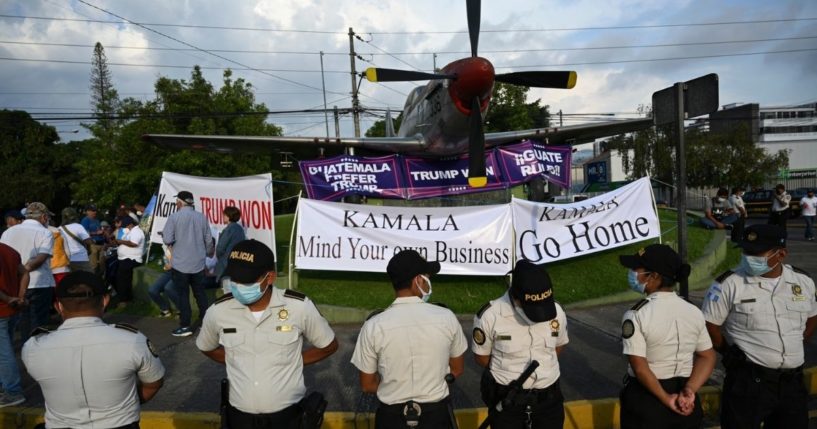
The U.S. vice president’s first foreign trip leaves controversy in its wake for a political figure on the rise in the administration.
“Do not come.” These words marked the first official foreign visit of Kamala Harris, the vice president of the United States. The sentence, uttered on Monday in Guatemala’s National Palace, was intended to change the minds of tens of thousands of Central Americans who plan to migrate north, fleeing violence, poverty and the effects of climate change. The words let loose a wave of criticism in the United States. Republicans and Donald Trump sympathizers have complained that Harris has still not visited the Mexican border, a task which President Joe Biden left to her with the hope of reducing irregular immigration. The most progressive members of the Democratic Party, on the other hand, were offended by the directness of the message, which they considered to be a low blow from an administration that wants to show a human side to contrast with the four years of xenophobic policies in the Trump era.
Harris is not Biden’s first high-ranking government official to broadcast a message to discourage illegal immigration. Secretary of State Antony Blinken communicated a similar theme in a virtual meeting with Mexican authorities when the Democrats had been in the White House for one month. However, the vice president, the first woman to occupy the position, did it from Central America with a head of state by her side, Guatemalan President Alejandro Giammattei. “This is disappointing,” said Rep. Alexandria Ocasio-Cortez, a left-wing Democrat, who noted in a tweet that migrating to the United States as a refugee is legal and that her country has spent decades “destabilizing” Latin America.
Jaini Pereyra, a political scientist at the London School of Economics and an expert in political discourse, believes the message fulfilled its objective and reached its intended audience — not the migrants, but U.S. citizens, especially Republicans. “It’s a sentence that Trump could have said. It is a short-term message for the Republicans because it weakens the signs that Trump has given that nothing is being done at the border,” states Pereyra, who emphasizes that the message was encoded.* Harris read it, which she did not do in other parts of the conference, and she did not repeat it afterwards during questions with the media.
Guatemala and Mexico have provided the vice president with her first experience in international politics. “As a political figure, she is evolving when it comes to negotiating and navigating important subjects with heads of state,” says Andrés Martínez, professor of journalism at Arizona State University and analyst of the U.S.-Mexico relationship. “Historically, vice presidents only leave the country to represent the commander in chief for inaugurations or funerals,” he adds.* The process of Harris’ political maturity is a point of obsession for Democrats, who consider her to be the natural successor to presidential candidacy in 2024, when Biden will turn 82. The president, however, has not ruled out running for reelection and believes he is the only one capable of beating Trump again, should it come to that.
The trip does not seem to have been a success. Various voices in the United States continue to question why Harris, tasked with dealing with the border situation, has still not visited the area. From Guatemala, the vice president said she would prefer to visit the places where there are problems with irregular emigration. The focus for the region was revealed by Harris and Blinken at the beginning of May, in the 51st Annual Washington Conference on the Americas. The last time Harris visited the Texas-Mexico border was to rally voters for Biden in November 2020.
On Monday, she stumbled during an interview with NBC. “Do you have any plans to visit the border?” journalist Lester Holt asked her. “I am here in Guatemala … At some point we are going to the border … we’ve been to the border … This whole thing about the border, we’ve been to the border,” the vice president responded. “You haven’t been to the border,” the reporter corrected. “And I haven’t been to Europe,” Harris said, nervously.
In the same interview, Biden’s number two, who has ended up the de facto person in charge of the relationship with Mexico, one of the most important trade partners for the United States, confirmed that the situation at the border was improving. But the data says otherwise. May once again broke records in a year that has documented the highest rate of undocumented immigration in two decades. March was the first month in which the highest number of arrivals was exceeded, with more than 173,000 people crossing the border. April was higher still. Last month 180,000 migrants crossed illegally.
Indeed, the number of unaccompanied minors migrating to the United States has reduced. What started as the most distinctive image of the crisis faced by the Biden administration in its first months is beginning to change. In March, almost 19,000 child and teenage migrants arrived unaccompanied. In May, there were 14,158, some 26% less. What continues to increase is the number of Mexicans who cross the border. Of the 180,000 border crossings which have been documented by the border authorities, 70,600 were Mexican citizens. In March, this number was 62,500. It is the highest number registered in five years among Mexican migrants.
Despite this, Harris took the criticisms and complaints away from the spotlights and microphones and discussed them instead in a private interview with President Andrés Manuel López Obrador. The conversation occurred before a bilateral meeting where, as well as migration, topics such as safety and business were discussed. “It’s a good sign. The situation calls for frank discussions behind closed doors,” adds Martínez.* A relationship in search of a new tone with its sights set on 2024.
*Editor’s Note: These quotations, accurately translated, could not be verified.

Leave a Reply
You must be logged in to post a comment.